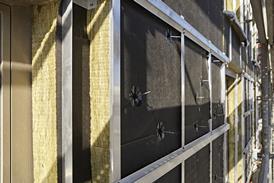Generating 60% of our schools’ energy from on-site renewable sources may sound like a great idea, but the figures don’t add up. Bill Watts takes today’s maths class
The government’s proposal for new secondary schools to generate 60% of their energy from on-site renewable sources (10 August, page 13) is admirable, but hopelessly misplaced.
The viable sources of on-site renewable electricity and heat generation for a building in the UK are wind and photovoltaic (PV) and solar thermal panels. All three are problematic. The use of solar thermal panels is limited to meeting the hot water load, which accounts for only a small part of total energy demand. The efficacy of a small-scale wind turbine installation is at best unproven, and large wind turbines are difficult to accommodate on all but the most rural sites.
This leaves PV panels to produce electricity. It is true that covering the roof with such panels would provide enough energy to meet the load, but this comes at significant cost. The capital cost of providing 1kWh of electricity per year from a PV panel on a roof is about £6, whereas an on-shore wind farm would produce it for 25p. (Off-shore wind currently costs in the region of 50p, owing to its early stage of development, and the need for grid reinforcement.)
The point is that the money invested in large-scale wind farms would get you 10 to 20 times as much power as the investment in PV panels on your building.
Unless it is grown on the school’s grounds, biomass is not an on-site renewable. It is grown off site and transported in a truck, train or boat and burned on the site. It is not a particularly convenient fuel. These days there is a surfeit of wood in forested areas of the UK, but then they used to say something similar about cod …
As long as we think that on-site renewables can solve our energy problems we will continue to tinker with the issue to little end
Surely then, the government’s money is best spent locally in focusing on reducing energy use and generating what we actually need in the most efficient manner – which is not necessarily on site. Putting money into on-site renewables shifts focus away from energy saving and fosters the misunderstanding that energy provision can be dealt with at a parochial level alone.
To illustrate the point, to meet the government’s 60% target in a 10,000m2 secondary school with a modest annual energy consumption of 100kWh/m2 using true on-site renewables would cost about £3.5m. By contrast, the cost of a portion of a remote, off-site wind farm to deliver 100% of the school’s energy would be £250,000-500,000, potentially leaving change from the government’s £500,000 per school to pay for energy-saving measures in the building itself.
The energy from the wind turbines would feed into, and travel over, the national grid. Some energy (5-10%) may be lost in transmission but with differences in initial capital cost of 1000-2000% I do not see that as an issue. And while a school could purchase a share of the wind farm, why should it? We live in a society and market economy where functions are divided up in an efficient and convenient manner. It is not the school’s job to own part of a wind farm.
As long as we think that on-site renewables can deal with our energy problems, we will continue to tinker with the issue to little end, and waste large sums of money in the process. We, as a society, should be clear in saying that we need renewables to work in the most cost-effective way. For large-scale projects that will make a difference this does require national planning and the design of a workable renewable energy infrastructure; the sort of thing governments do.
Postscript
Bill Watts is senior partner at Max Fordham
What do you think? Email building@cmpi.biz or comment via the ‘what you think’ link.
Read ‘Tough energy target at BSF’ at www.building.co.uk/archive




























No comments yet